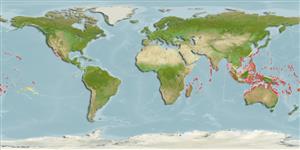Common names from other countries
>
Eupercaria/misc (Various families in series Eupercaria) >
Labridae (Wrasses) > Corinae
Etymology: Thalassoma: Greek, thalassa = the sea + Greek, soma = body; the colour of the sea (Ref. 45335).
More on author: Lacepède.
Environment: milieu / climate zone / depth range / distribution range
экология
морской ассоциированный с рифами; пределы глубины 0 - 10 m (Ref. 1602). Tropical; 30°N - 28°S
Indo-Pacific: East Africa to the Pitcairn, north to the Ryukyu Islands, south to Tonga and Rapa.
Size / Вес / Возраст
Maturity: Lm ? range ? - ? cm
Max length : 30.0 cm TL самец/пол неопределен; (Ref. 4392)
колючие лучи спинного плавника (общее число) : 8; членистые (мягкие) лучи спинного плавника (общее число) : 13; колючие лучи анального плавника: 3; членистые (мягкие) лучи анального плавника: 11. This species is distinguished by the following characters: greatest body depth 2.7-3.6 in SL; pectoral fin rays usually 16; lateral line scales 25; total gill rakers on first gill arch 17-24 (modally 20); caudal fin of initial phase slightly rounded to truncate, of terminal males truncate to slightly double emaginate; Body of initial (female) phase greenish grey to pale green with 5-6 dark saddles on back, pair of dark (sometimes diffused) stripes on side, a dark vertical line on most scales of body, and with a diagonal (or C-shaped) pink to dark red below front of eye; while body of terminal male salmon-pink to orange anteriorly, with 2 longitudinal series of vertical green rectangles, every fourth pair of upper series extending as a single green bar across back, the head orange-brown without bands and caudal fin brownish to greenish, shading distally to pink, the posterior third of rays blue (Ref. 9823, 86689, 90102).
Found solitary or in groups (Ref. 90102) in shallow exposed reef flats, usually with rock-base and mixed coral and algae (Ref. 48636, 58302). Also occurs in surge-swept reef flats, reef margins, and clear rocky shorelines, but may venture to deeper waters up to 10 m (Ref. 3921). Benthopelagic (Ref. 58302). Feeds on crustaceans (especially crabs), mollusks, and ophiuroids (brittle stars) (Ref. 3921).
Life cycle and mating behavior
Maturities | размножение | Spawnings | Egg(s) | Fecundities | личинки
Oviparous, distinct pairing during breeding (Ref. 205).
Randall, J.E., G.R. Allen and R.C. Steene, 1990. Fishes of the Great Barrier Reef and Coral Sea. University of Hawaii Press, Honolulu, Hawaii. 506 p. (Ref. 2334)
Статус Красного Списка МСОП (Ref. 130435)
CITES (Ref. 128078)
Not Evaluated
Угроза для людей
Harmless
Использование человеком
рыболовство: не имеет хозяйственного значения; аквариум: коммерческий
дополнительная информация
инструменты
Специальные отчеты
Скачать в формате XML
ресурсы в Интернет
Estimates based on models
Preferred temperature (Ref.
115969): 24.9 - 29.3, mean 28.3 (based on 2665 cells).
Phylogenetic diversity index (Ref.
82804): PD
50 = 0.5000 [Uniqueness, from 0.5 = low to 2.0 = high].
Bayesian length-weight: a=0.00955 (0.00430 - 0.02123), b=3.06 (2.89 - 3.23), in cm Total Length, based on LWR estimates for this Genus-body shape (Ref.
93245).
Trophic level (Ref.
69278): 3.8 ±0.58 se; based on food items.
устойчивость к внешним воздействиям (Ref.
120179): средний (среднего размера), минимальное время удвоения популяции 1.4-4.4 года (Preliminary K or Fecundity.).
Fishing Vulnerability (Ref.
59153): Low vulnerability (20 of 100).
